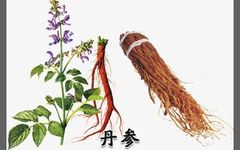| Danshen (Salvia miltiorrhiza) is a traditional Chinese medicine,Danshen primarily functions to invigorate blood circulation and eliminate blood stasis. The active component, danshenone, has the effect of promoting blood circulation and removing blood stasis. By invigorating blood circulation, it improves blood supply to the cardiovascular and cerebrovascular systems. |
Doctors say:
Danshen contains danshenone, which is a strong menstrual regulator, primarily effective in dispelling stasis, promoting regeneration, and invigorating blood circulation. It is commonly used in the treatment of coronary heart disease, neurasthenia, and acute and chronic hepatitis. It can also be used in gynecology to assist in treating uterine bleeding, irregular menstruation, blood stasis, abdominal pain, lymphadenitis, dysmenorrhea, and amenorrhea. It can be taken orally or applied externally. Externally, it can be used to wash sores.
Effects and Functions of Danshen
① Liver Protection:
Danshen has an inhibitory effect on various bacteria, including Mycobacterium tuberculosis. Among its effects, it is said to protect the liver by inhibiting or alleviating liver cell degeneration, necrosis, and inflammatory responses, promoting liver cell regeneration, and having an anti-fibrotic effect, which can improve liver microcirculation. If there is hepatitis B, it can be taken appropriately, but not exceeding half a month. However, if there are no liver issues and the patient is young, it is not recommended to take it, as any medication has side effects.
② Lowering Blood Lipids:
The primary function of Danshen is to invigorate blood circulation and eliminate blood stasis, often used in the treatment of coronary heart disease. Danshen can also lower blood lipids and inhibit the formation of coronary atherosclerosis, but it is recommended to be taken with other Chinese herbs. However, for patients with severe hyperlipidemia considering the use of Danshen for treatment, it is advised to seek systematic treatment at a reputable hospital.
③ Invigorating Blood:
It can dilate coronary arteries, increase coronary blood flow, improve myocardial ischemia, infarction, and cardiac function, enhance myocardial contractility, and regulate heart rhythm. It can also dilate peripheral blood vessels, increase blood flow, decrease cerebral blood flow, and improve microcirculation. It shortens the recovery period of red blood cells and hemoglobin, increases reticulocyte count, promotes tissue repair, and shortens healing time. It can enhance the body’s tolerance to hypoxia.
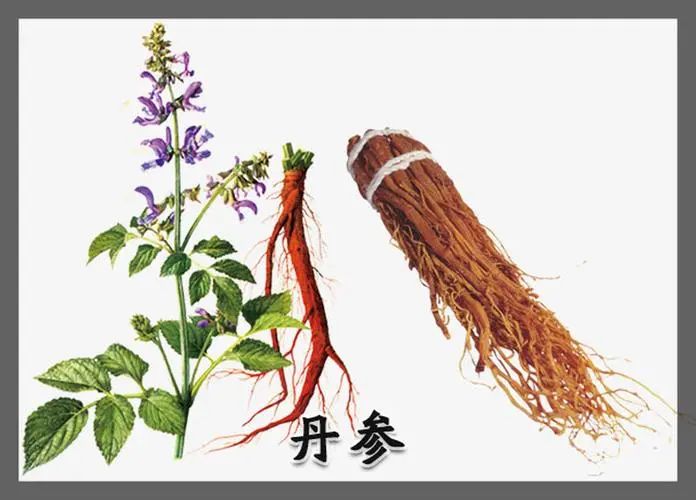
【Pharmacological Knowledge】
【Chinese Medicine Name】Danshen (Salvia miltiorrhiza)
【Alias】Qiechan grass, red ginseng, wood sheep’s milk, zhuma, benma grass, mountain ginseng, purple Danshen, red root, mountain red radish, blood-activating root, kaoshan red, red ginseng, selected wine pot root, wild perilla root, mountain perilla root, dahongpao, honey canned, blood ginseng root, duoduo flower root, honey jar, red Danshen
【English Name】Salviae Miltiorrhizae, Radix Et Rhizoma.
【Source】The root and rhizome of the plant Salvia miltiorrhiza Bge. from the Lamiaceae family.
【Identification of Medicinal Material】
The dried rhizome often has residual stem bases, with 1 to several long slender branches. The root is slightly cylindrical, slightly curved, sometimes branched, with many fine fibrous roots, about 10-25 cm long, 0.8-1.5 cm in diameter, with lateral roots about 5-8 cm long and 2-5 mm in diameter, the surface is brownish-red to brick-red, rough, with irregular longitudinal wrinkles or cork, often peeling in scales. It is hard and brittle, easy to break, with an uneven fracture surface, with a horn-like or fibrous texture, the bark is darker, purple-black or brick-red, and the wood part has vascular bundles that are gray-yellow or yellow-white, arranged radially. It has a weak aroma and a slightly bitter taste. The best quality is thick, with a purple-black interior and chrysanthemum-like white spots.
Mainly produced in Anhui, Shanxi, Hebei, Sichuan, Jiangsu, etc. Additionally, it is also produced in Hubei, Gansu, Liaoning, Shaanxi, Shandong, Zhejiang, Henan, Jiangxi, etc.
Moreover, there are several other plants whose roots are also used as Danshen in some regions:
① Gansu Danshen, with conical roots. Leaves are mostly basal or at the lower part of the stem, with ten triangular or ovate-lanceolate leaves, heart-shaped or spear-shaped at the base. Used in Gansu, Ningxia, Qinghai, Yunnan, Tibet.
② Brown-haired Danshen, with the underside of the leaves densely covered with brown soft hairs. Used in Gansu, Ningxia, Qinghai, Yunnan.
③ Yunnan Danshen, with fleshy, thick, spindle-shaped roots, clustered. Leaves are basal, with single leaves or pinnate compound leaves, single leaf blades are ovate or long oval, slightly heart-shaped at the base, with many wrinkles and soft hairs on both sides, with round teeth on the edges; pinnate compound leaves have 3-5 leaflets. The umbellate inflorescence has 4-6 flowers, arranged in a loose raceme at the top of the stem; the flower crown is blue-purple. Used in Yunnan.
【Distribution】Grows in hillside grasslands, under forests, and by streams. Distributed in Gansu, Sichuan, Guizhou, etc.
【Harvesting and Processing】Harvest in autumn, remove stems, leaves, and fibrous roots, clean the soil, and dry.
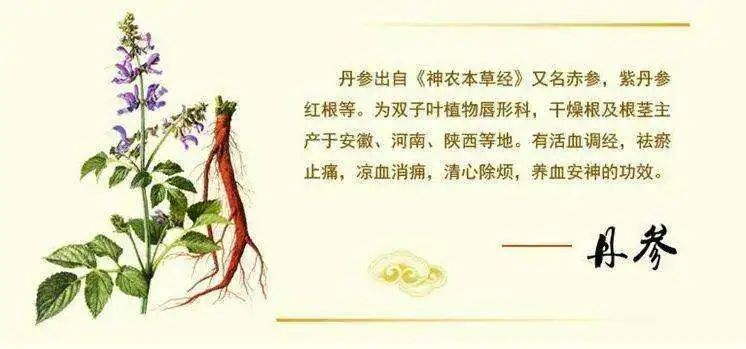
【Nature and Taste】 Slightly cold in nature, bitter in taste. It enters the Heart and Liver meridians.
【Effects and Functions】 Dispels stasis and relieves pain, invigorates blood and regulates menstruation, clears the heart and eliminates irritability. It belongs to the category of blood-invigorating and stasis-eliminating medicines.
【Clinical Applications】 Dosage of 9-15 grams, decocted for oral administration, with a maximum dosage of 30 grams. Used to treat irregular menstruation, amenorrhea, dysmenorrhea, abdominal masses, chest and abdominal stabbing pain, heat bi pain, sores and swelling, irritability and insomnia; liver and spleen enlargement, angina pectoris.
【Pharmacological Research】 The preparation can cause dilation of coronary arteries in experimental animals, significantly improving heart function. The injection has anticoagulant effects. The extract has antibacterial effects in vitro. Danshenone is an effective antibacterial component. It protects the cardiovascular and cerebrovascular systems; lowers blood lipids; prevents atherosclerosis; invigorates blood and eliminates stasis; enhances tolerance to hypoxia; boosts immune function; has anti-inflammatory and anti-allergic effects; protects the liver; prevents gastric ulcers; has anti-tumor effects; provides sedation and analgesia; protects the respiratory system; improves kidney function; has antioxidant and antibacterial properties; promotes healing of skin wounds and fractures; has hormone-like effects.
【Chemical Components】 Contains danshenone I, danshenone II A, danshenone II B, hidden danshenone, lithospermic acid B, danshenone lactone, dihydrodanshenone, danshenic acid ethyl, dihydroisodanshenone I, danshenol, danshen lactone, tigogenin, β-sitosterol, and other components.
【Contraindications】 Contraindicated in cases of excessive menstruation without blood stasis, and should be used with caution in pregnant women. It is not suitable to be used with Rhizoma et Radix of Veratrum.
【Formulations】 For reference only
① For treating scanty menstrual blood and postpartum blood stasis abdominal pain, amenorrhea abdominal pain: Danshen, Yimucao, and Xiangfu, each 9 grams, decocted in water. (From “Selected Chinese Herbal Medicines from Shaanxi, Gansu, Ningxia, and Qinghai”)
② For treating miscarriage with blood below: 360 grams of Danshen. Use five liters of wine, boil to obtain three liters, take one liter warm, three times a day. (From “Essential Prescriptions from the Golden Chamber”)
③ For treating abdominal pain due to half deficiency and half excess: 30 grams of Danshen, 4.5 grams each of sandalwood and amomum. Decoction for oral administration. (From “Song of the Current Formulations”)
④ For treating acute and chronic hepatitis with pain in both flanks: 15 grams of Yinchenshu, 9 grams each of Yujin, Danshen, and Banlangen. Decoction for oral administration. (From “Selected Chinese Herbal Medicines from Shaanxi, Gansu, Ningxia, and Qinghai”)
⑤ For treating dysmenorrhea: 15 grams of Danshen, 6 grams of Yujin. Decoction, one dose per day, divided into two doses. (From “Compilation of National Chinese Herbal Medicines”)
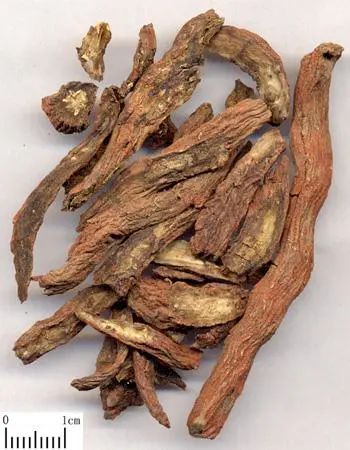
Methods and Standards for Processing Danshen
【Ancient Processing Methods】 In the Tang Dynasty, there was a method of “boiling until purple” (from “Essential Prescriptions”). In the Song Dynasty, there were methods of slight roasting to black (from “General Record”), and baking (from “Precious Products”). In the Ming Dynasty, methods of washing with wine (from “Human Door”), soaking in wine (from “Original”), and frying with wine (from “Distinction”) were added. In the Qing Dynasty, methods of stir-frying with pig heart blood (from “Harm and Benefit”) and steaming with wine (from “Flower Pen”) were added.
【Modern Processing Methods】
1. Danshen: Take the original medicinal material, remove impurities and residual stems, wash clean, moisten thoroughly, cut into thick slices, and dry. Sift out debris.
2. Wine Danshen: Take Danshen slices, add a specified amount of yellow wine, mix well, let it sit to absorb the wine, and after the wine is fully absorbed, place it in a frying container, heat gently, and fry until dry, then take out and cool. Sift out debris. For every 100 kg of Danshen slices, use 10 kg of yellow wine.
【Purpose of Processing】 Danshen is bitter and slightly cold in nature. It enters the Heart and Liver meridians. It has the functions of dispelling stasis and relieving pain, invigorating blood and regulating menstruation, and clearing the heart and eliminating irritability. It is used for irregular menstruation, amenorrhea, dysmenorrhea, abdominal masses, chest and abdominal stabbing pain, heat bi pain, sores and swelling, irritability and insomnia, liver and spleen enlargement, and angina pectoris.
Danshen is mostly used raw. The raw product has strong effects in dispelling stasis and relieving pain, clearing the heart and eliminating irritability, and can promote blood circulation, effectively regulating women’s menstrual irregularities. Due to its slightly cold nature, it is often used for sores and abscesses caused by blood heat and stasis, postpartum stasis pain, amenorrhea abdominal pain, chest and abdominal pain, and limb pain. After processing with wine, its cold nature is moderated, enhancing its blood-invigorating and stasis-eliminating effects, and it can promote blood circulation, effectively regulating women’s menstrual irregularities. It is often used for irregular menstruation, blood stasis amenorrhea, postpartum lochia not discharging, chest pain, and abdominal masses.
【Appendix】
1. Modern processing methods also include wine frying, rice frying, frying, and wine moistening with bran frying.
2. Literature excerpt: “Fried with wine. Avoid salty water and vinegar. Soaked in wine, it can treat foot bi.” (from “Distinction”)

【Wine Processing】
(1) For irregular menstruation: Use Danshen powder alone, taken with aged wine, has the effect of invigorating blood and eliminating stasis, regulating menstruation and relieving pain, used for irregular menstruation, postpartum lochia not discharging, such as Danshen powder (from “Women’s Ming Theory”); if used with Chuanxiong, Yimucao, and Taoren, it can enhance the effect of invigorating blood and eliminating stasis, used for postpartum abdominal pain, lochia not discharging, or discharging but not smooth.
(2) For abdominal masses: Often used with Peony root, Rhizoma et Radix of Veratrum, and Oysters, can enhance the effect of resolving masses and breaking up accumulations, used for qi and blood stagnation, stasis in the abdomen, gradually accumulating lumps, or distension or pain.
(3) For rheumatic bi pain: Often used with Qin Jiao, Wei Ling Xian, and Du Huo, has the effect of unblocking collaterals and relieving bi pain, used for wind-cold-damp obstruction of meridians, stagnation leading to heat transformation, joint swelling and pain, such as Du Huo San (from “Universal Prescriptions”).
| =====Previous Classics======
Traditional Chinese Medicine – The Effects and Functions of Huangjing, Nourishing Qi and Yin, Strengthening the Spleen, Moistening the Lungs, and Benefiting Kidney Function Traditional Chinese Medicine – Agarwood, Promoting Qi, Relieving Pain, Warming the Middle, Stopping Vomiting, and Regulating Breathing Traditional Chinese Medicine – The Effects and Functions of Huo XiangTraditional Chinese Medicine – The Effects and Functions of Hua Ju HongPortulaca oleracea is known as a “natural antibiotic”; what are its effects and functions? Let’s hear what the experts sayTraditional Chinese Medicine Collection (1)Health Science Popularization CollectionTraditional Chinese Medicine – The Effects and Functions of Niu Huang and Its ContraindicationsStomach Nourishing and Spleen Strengthening Acupoint ExerciseSummer Health – A cup of ginger and jujube tea in the morning, promoting digestion, expelling dampness, nourishing blood, and replenishing Qi, clearing out internal pathogenic Qi, and can also aid in weight loss oh61 high-definition tongue diagnosis charts, with text and image comparison, collector’s edition[Recommended] Easy to learn, step-by-step guide to cupping (Cupping Encyclopedia) |
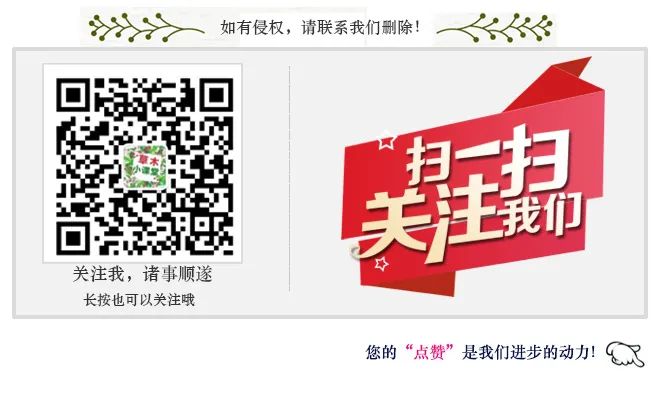
Reminder:Note:Do notusemedicationswithoutfollowingmedicaladvice.

